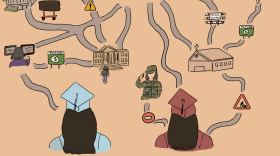-
For children of long-term visa holders who've waited years to be approved for green cards, graduating college represents a challenging transition period of trying to find work or be approved for new visas in order to stay in the country. And for those graduating this year, that transition has become more challenging under the Trump administration's approach to immigration.
-
After 35 years in operation, Neo-China in Durham closed its doors at the end of May. The family-owned Chinese restaurant struggled to keep up with rising operational costs, including the increased prices of imported Chinese goods that resulted from the high tariff earlier this spring.
-
Efforts to mandate Asian American Pacific Islander history in North Carolina schools continue to be stalled on the state level. Meanwhile, Green Hope High School in Cary plans to pilot the Asian American history elective for Wake County Public Schools this fall.
-
Small businesses that depend on imported Chinese goods, like Asian restaurants and grocery stores, are grappling with rising costs due to the 145% tariff on China.
-
The number of Asian grocery stores and supermarkets in the NC Triangle have grown significantly since the 1990s, reflecting the rapid growth of the Asian population in the area. The stores have also become gathering spaces for folks across the diaspora, looking for flavors that remind them of home.
-
Since 2020, registered Asian American, Native Hawaiian and Pacific Islander voters in North Carolina grew by 31% and about 72,000 voted early for the 2024 election. But Asian American organizers say many found the vote-by-mail process challenging, and that tensions have increased between parties at the polls.
-
The town of Cary is asking its residents to vote on a $560 million parks and recreation bond measure during this election cycle. Many believe the rapidly growing area needs more recreational facilities, while others balk at the proposed 26% property tax increase.
-
Many of North Carolina's Hmong residents live in western North Carolina, which was badly impacted by Helene. Community leaders say that families, especially older folks, need access to Asian food staples and language interpretation assistance to apply for federal disaster relief funds.
-
Indian American voters are excited about the possibility that Vice President Kamala Harris, being of Indian and Jamaican descent, could become the Democratic nominee for president. Indian Americans also make up the largest portion of North Carolina's rapidly growing Asian American and Pacific Islander population.
-
A team of two artists and an oral history scholar created a mural next to Union Station in Raleigh. It’s dedicated to recognizing joy and belonging for Asian American, Native Hawaiian, and Pacific Islanders who live in North Carolina.
Play Live Radio
Next Up:
0:00
0:00
Available On Air Stations










